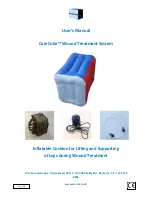
www.petsafe.net
11
FR
IT
NL
DE
EN
ES
2. Thread the In-Line Plug through the Cord Pass-Through in the back left corner of the Bowl
(
Fig. 16
). To insure the Pet Fountain bowl is stable, run the electrical Power Cord along
the back of the Pet Fountain and through the notch in the base of the Bowl (
Fig. 17
).
3. To attach the Housing, align the Housing over the Pump and then the Bowl. Line up the
Intake Tube to fit directly into the Pump. Once in place, gently push down on the
Housing, locking it into place.
4. Replace the Pre-Filter over the Flow Control Knob by
sliding the narrow end in first. The lip on the top of the
Pre-Filter will be facing the front of the Pet Fountain,
push down to snap it into place over the Flow Control
Knob (
Fig. 18
).
5. Replace the Charcoal Filter with the white side facing the
front of the Pet Fountain towards the spout.
6. Fill the Bowl and Housing with water and replace the
Housing Lid.
7. Before you plug in the Pet Fountain, make sure the electrical Power Cord, the plug and
your hands are dry. Plug the Pet Fountain into a standard electrical wall outlet.
8. Set the desired water flow rate with the Flow Control Knob, which islocated to the
right of the receiving ramp. When the Flow Control Knob is in the 10 o’clock position,
flow is at its lowest. When the Flow Control Knob is in the 2 o’clock position, flow is at
its highest.
The Pet Fountain and Your Environment
If you live in a humid environment and have problems with mold or algae, soak all Pet
Fountain parts in a diluted vinegar solution (20% white vinegar and 80% water) for 10
minutes after regular cleaning. Also, pour the diluted vinegar solution into the Pump’s
motor cavity.
If you have hard water, small white mineral deposits may form on or inside the Pump.
This can eventually prevent the Impeller from turning properly. To avoid replacement or
damage to the Pump, please take the following precautions:
• Clean the Pump more frequently.
• Clean the Pump with a diluted vinegar solution weekly.
• Use bottled water instead of tap water.
Fig. 17
Notch
Fig. 16
Cord
Pass-
Through
MIN
MAX
Fig. 18
.












































